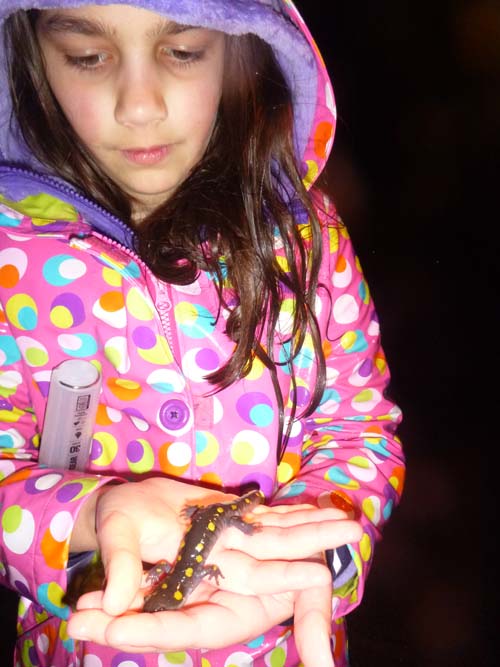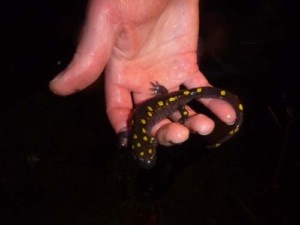So, what is this ‘Big Night’?

By Colin Holme
Executive Director
Lakes Environmental Association
I first heard of the marvel of “Big Night” years ago from my friend and co-worker, Bridie McGreavy. It all sounded amazing but I have to say, I was also skeptical. Not skeptical of an amazing natural phenomenon…just skeptical of the name “Big Night.” It sounded a little ostentatious. With that kind of terminology, I was expecting a lot of commercials and maybe a half-time show.
Avid Bridgton News readers will recognize the term “Big Night” from various articles of the recent and distant past. But I don’t like to make assumptions, so let me take a minute to explain what “Big Night” is supposed to be.
Maine’s frogs and salamanders have been sitting all winter in a cryogenic state where their whole bodies have basically frozen. The temperature warms up in the spring, the rains start falling and seeping into the ground, and their bodies thaw. Then they magically wriggle back to life. This isn’t Big Night though, this is just the immediate precursor.
So once these creatures figure out they are alive again, they want to get to work on priority number one. Procreation. And to do that, they need to travel from their winter homes to pools of water, where they can frolic and make merry with the opposite sex. That is where the eggs are laid, and the young eventually hatch and begin their amazing life cycles.

So, what is Big Night? It is the first night in the spring after the majority of the snow and ice is gone, when it is 40 degrees or warmer, and it is raining. When all those things come together, amphibians move en masse from the winter hideouts to the breeding pools. This is the time to witness a spectacular migration and one of the few times you can get to see Maine’s mole salamanders.
But the truth is, it often doesn’t always happen quite like that. Many years, it is a succession of small nights, sometimes a couple big nights. Sometimes they get desperate and they move when it is not even raining. And for these reasons, I think it should be called “Big Nights” instead. And also, “A Broad Spectrum of Nights” does not sound as good.
So last Thursday, all the natural elements aligned and we geared up at 8 p.m. to go see if we could find some salamanders. The first rule of Big Nights is to wear a waterproof outer layer and dress warmly. No one likes to be cold. Then we all grabbed the best flashlights we could find. I took the flashlight that comes with my portable drill. It gives off a spotlight that a kangaroo poacher would be envious of. To protect it from the elements, I put a large zip-lock bag over it.
Once geared up, we headed out on the road by our house. It is not the best spot, but it works and roads are an easy place to spot the frogs and salamanders. We slogged down the road a couple hundred feet to join up with my children’s cousin and then we slogged some more. Initially, it was a disappointing Big Nothing.
But then my wife saw our first yellow spotted salamander. A nice fat one! It was about eight inches long and must have been quite old. Which for salamanders, could be 20 years… And so the night began. Similar to fishing, it doesn’t quite make sense until you catch your first fish. But there are no worms to gore or hooks to remove. Instead, we just simply move the little guys off the road in the direction they were heading. They probably did not need the help last Thursday, since there was no traffic, but that made it safer for us. And since there was no school the next day, we stayed up “helping” the little critters for longer into the night.
Although we did not observe a mass migration of amphibians last Thursday, we did see some of the biggest salamanders I have ever seen. So this is good news for you. Big Nights isn’t over yet! If you go out on the next rainy night, I bet you will see salamanders, peepers, and wood frogs too. I recommend starting after 8 p.m., wearing reflective clothing, and washing your hands with regular tap water first to keep chemicals off their sensitive skin. Bring some kids if you can and definitely a camera. This will make it a lot more exciting. If you want to make it official and report your findings, send photos to mary@mainelakes.org.
Enjoy those rainy nights and stay safe!

